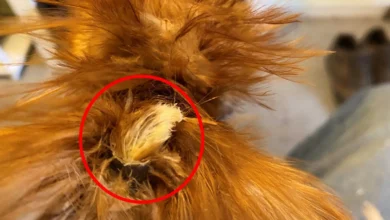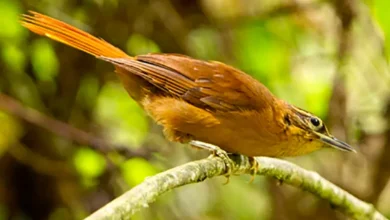The Emerald Toucanets (Aulacorhynchus prasinus) are small to medium-sized toucans found in Central and South America, where they inhabit humid forests and more open woodland – mostly at higher elevations.
Emerald Toucanets typically forage on fruit, lizards, insects, bird eggs and nestlings. They frequently move together in small flocks of 3 to 10 birds.

Several well differentiated groups have been identified over their large range, which differ in size, plumage and bill coloration. The plumage in all subspecies is mostly green.
The different subspecies are most commonly identified and named for the color of the throat, which ranges from white, grey, green, blue to black. The bill is black with varying amounts of yellow on the upper bill (maxilla).
The distinctive blue-throated form of Nicaragua, Costa Rica and western Panama has been separated as the Blue-throated Toucanet, Aulacorhynchus caeruleogularis – however, several resources still list them as subspecies of the Emerald Toucanets.
They are fairly long-lived with a lifespan around 20 years.
Distribution / Habitat
Emerald Toucanets occur from tropical Mexico – from San Luis Potosi south through Central America (Costa Rica, Panama), and South America – Colombia, Ecuador, northern Venezuela, eastern Peru, western Brazil and Bolivia (central Bolivian Andes to Santa Cruz).
They typically occur in humid montane forests, along forest edges, second growth adjacent to forests, plantations and clearings with scattered trees at elevations from 2,000 – 10,000 feet (600 – 3,100 meters), favoring the higher altitudes. Only in Mexico and in southwestern Amazonia (southern Peru, western Brazil and northern Bolivia) do they occur in lowland evergreen forests down to 820 feet (250 meters).
Subspecies, ID and Ranges
Species taxonomy is somewhat controversial, seemingly ever changing and heavily discussed. However, most resources / authorities at this point in time appear to be agreeing on the below …
Emerald Toucanet (Aulacorhynchus prasinus prasinus – Gould, 1834) – Nominate Race
- Includes (arguably) up to 17 subspecies, with geographical differences and variations in size and the color of the throat and the bill.
- Range: Found in eastern Mexico (southeastern San Luis Potosí to northern Oaxaca) south and east to Yucatán, Belize, northern Guatemala, and south to Nicaragua
- ID: White or whitish throat. The upper beak (maxilla) is extensively yellow.
Aulacorhynchus prasinus volcanius (Dickey and van Rossem, 1930)
- Range: San Miguel Volcano slopes / Volcán San Miguel, in eastern El Salvador
- ID: Geographic location and white band at the base of the bill differentiates it from the prasinus (nominate) and wagleri groups.
Aulacorhynchus prasinus chiapensis (Brodkorb, 1940)
- Southern Mexico in Chiapas and western Guatemala. This subspecies has been considered as a synonym of stenorhabdus or of virescens
- ID: Geographic location and white band at the base of the bill differentiates it from the prasinus (nominate) and wagleri groups.
Aulacorhynchus prasinus stenorhabdus (Peters, 1948)
- By many considered one and the same species with below ssp. virescens
- Range: Found in western Guatemala and northern El Salvador.
- ID: Geographic location and white band at the base of the bill differentiates it from the prasinus (nominate) and wagleri groups.
Aulacorhynchus prasinus virescens (Ridgway, 1912)
- Range: Southeastern Mexico in the State of Quintana Roo, Belize, Northern Guatemala, Honduras and northern Nicaragua
- ID: Geographic location and white band at the base of the bill differentiates it from the prasinus (nominate) and wagleri groups
Aulacorhynchus prasinus warneri (Winker, 2000)
- Range: Restricted to the Sierra de Los Tuxtlas area in southern Veracruz in southeastern Mexico.
- ID: Resembles the nominate prasinus, but can be distinguished by the yellowish wash to the throat and the yellowish band on the feathers covering the ears (auriculars).
The below species are by some authorities considered separate species (particularly in recent history); although many resources continue to list them as subspecies:
Wagler’s Toucanet (Aulacorhynchus [prasinus] wagleri – Sturm, 1841)
- Range: Found in southwestern Mexico: Sierra Madre del Sur, Guerrero and southwestern Oaxaca
- ID: The male’s average weight is 6.5 oz (183.7 grams). Females tend to be smaller. The bill is mostly black, with a broad yellow stripe along the the upper ridge of the bill (culmen). The forecrown is paler and yellower. Throat white (as in the prasinus group) but the rear margin is bluer.
- The bill is black with yellow to the upper lower bill (mandible)
Blue-throated Toucanet (Aulacorhynchus [prasinus] caeruleogularis – Gould, 1854).
- Incl. subspecies maxillaris (Griscom, 1924)
- Found in the Costa Rican mountains south to the eastern parts of the province of Chiriquí ( located on the western coast of Panama) and the province of Veraguas (located in the center-west of the country).
- ID: The only members of this group where the throat and the lower sides of the face are deep blue. The bill is mostly black, with a broad yellow stripe along the upper ridge of the bill (culmen). There is a rufous patch near the base of the upper lower bill (mandible).
Violet-throated or Nelson’s Toucanet, Goldman’s Blue-throated Toucanet (Aulacorhynchus [prasinus] cognatus – Nelson, 1912)
- Found in central and eastern Panama, south to the adjacent Chocó region of northwestern Colombia.
- The throat is pale grey ranging to blue. The bill is mostly black, with a yellow stripe along the upper ridge of the bill (culmen). The bare skin around the eyes is orangey to grey.
Santa Marta Toucanet (Aulacorhynchus [prasinus] lautus – Bangs, 1898)
- Found in the Santa Marta mountains in northeastern Colombia
- ID: Pale grey-blue throat. Blue feathers surround the bare yellow-to-orange skin around the eyes. The bill is mostly black with yellow markings being restricted to the upper ridge of the bill (culmen). There also often is some chestnut or maroon near the base of the lower bill (mandible).

(Northern) Andean Toucanet or White-throated Toucanet (Aulacorhynchus [prasinus] albivitta – Boissonneau, 1840)
- Incl. below subspecies griseigularis and phaeolaemus.
- Found in the Andes from northwestern Venezuela, along the east slope of the Central Andes and both slopes of Eastern Andes of Colombia, and eastern Andes of northern Ecuador.
- ID: The throat is white.
Grey-throated Toucanet (Aulacorhynchus [prasinus] griseigularis – Chapman, 1915)
- Found in Colombia – specifically in the northern portion of the Western Andes and the west slope of the Central Andes.
- ID: Pale grey throat. The bill is mostly black, with a broad yellow stripe along the upper ridge of the bill (culmen), and some chestnut near the base of the lower bill (mandible). There is a white vertical stripe at base of the bill.
Aulacorhynchus [prasinus] phaeolaemus (Gould, 1874)
- Range: Found along the western slope of the Western Andes in western Colombia, north of the Patia Canyon)
- ID: Pale blue throat. Bill mostly black, with a broad yellow stripe along the upper ridge of the bill (culmen), and some chestnut near the base of the lower bill (mandible). There is a white vertical stripe at the base of the bill.
Black-throated or Peruvian Toucanet (Aulacorhynchus [prasinus] atrogularis – Sturm, 1841)
- Incl. below subspecies dimidiatus and cyanolaemus.
- Range stretches from southern Ecuador, through northern Peru, far western Brazil (in the state of Acre), to central Bolivia (western Santa Cruz) .
- ID: Black throat. The bill is mostly black, with broad yellow stripe on the upper ridge of the bill (culmen).
Aulacorhynchus [prasinus] dimidiatus (Ridgway, 1886)
- Range: Occurs in the hills and lowlands from southeastern Peru to western Brazil and northern Bolivia.
- ID: Black throat. The bill is mostly black, with broad yellow stripe on the upper ridge of the bill (culmen). Resembles ssp. atrogularis, but is smaller size and has a shorter bill.
Aulacorhynchus [prasinus] cyanolaemus (Gould, 1866)
- Range stretches from the eastern Andean slope of southeastern Ecuador to northern Peru.
- ID: Deep blue throat. The bill is mostly black a yellow-tipped upper bill (maxilla).
Description:
The Emerald Toucanets have a mainly emerald green plumage (for which they were named), except for a bronzy tinge on the crown and forecrown, a yellowy bronze tint on the upper back, a blue patch around each eye, and the chestnut or rufous-colored vent and tail-tip.
The underparts are paler than the plumage above. The throat color also varies by subspecies – whitish, blue or black. They measure from 12 to 15 inches (30 – 37 cm) in length (from top of the head to the tip of the tail) and weigh from 4.2 to 8.1 oz (118 – 230 grams).
The bill is heavy and long; the upper bill (maxilla) is extensively yellow and the lower bill (mandible) is black. The amount of yellow varies between the different subspecies. The skin around the eyes (orbital skin) is black. The eyes are grey-brown to brown or chestnut.
The legs range in color from dull greyish to bright green.
Both female and male adults are alike in appearance, although females tend to be smaller and shorter-billed.
Juvenile Emerald Toucanets are duller (greyer, less yellow and the chestnut areas are browner), with a greyish throat and the black areas of the bill replaced with dusky.
Similar Species
- From Mexico south through Panama, no other green toucan occurs naturally – so confusion is unlikely.
- From Venezuela south to Bolivia, they could be confused with several species of the Groove-billed Toucanets (Aulacorhynchus). However, in most cases, the Emerald Toucanet can be distinguished by the color of the bill, as the Aulacorhynchus generally lack yellow markings on the upper bill. The exception to this is the Yellow-billed Toucanet (Aulacorhynchus sulcatus calorhynchus) which has considerable amounts of yellow on the both the upper and lower bill (please refer to image). Their ranges meet in the Sierra Nevada de Santa Marta in northern Colombia, in the Sierra de Perijá along the Colombia/Venezuela border, and in the Andes of northwestern Venezuela. The Yellow-billed Toucanet lacks the chestnut markings on the vent and tail tip.
Breeding / Nesting
In Mexico, most breeding activities have been observed from March to July; in Costa Rica from March to August; and in Colombia from January to June.

The mating ritual is a fun-loving affair for toucans, as they throw fruit to one another. During courtship and the actual act of mating, both birds are observed feeding each other.
Like all of their other activities, nesting happens in hollow areas in trees, 6.6 – 89 feet (2 – 27 meters) above the ground. In most cases, they will take advantage of abandoned woodpecker nests or use other natural cavities. The bill is not effective for digging or any other type of extensive excavation work and so they must rely on holes already formed by other means.
The nests are not lined, but the 1 – 5 (average 3 – 4) glossy white eggs that are laid each year rest on a few wood chips created while enlarging the opening or on various kinds of regurgitated seeds collected for this purpose. Parents share equally in incubation duties, but rarely sit on the nest for more than an hour at a time and the eggs are often left uncovered. The incubation period lasts about 14 – 16 days to hatching. The hatchlings are completely helpless, blind and naked. Babies have pads on their elbows that protect their feet by keeping them elevated until they fledge. The bill is small and unremarkable until about 16 days old when it takes on the distinguishing features of the toucan, and requires up to four months to develop fully. Feathers begin to expand at 4 weeks. They fledge (leave the nest) when they are about 42 – 45 days old.
Both parents share in feeding fruit and animal prey to the chicks for up to 8 weeks.
Breeding in captivity requires an excellent knowledge of their requirements, and even then hatching rates are as low as 30%.
Captivity
Emerald Toucanets are quite popular as pets due to their small size and quiet nature, which makes them suitable for apartment living (if allowed to roam around throughout a good part of the day). Hand-raised birds are typically also very affectionate and playful. In fact, they are said to be as cuddly as cockatoos, and are quite trainable as well.
Calls / Vocalizations / Sounds
Their calls are repeated rronk- rronk- rronk or wup-wup-wup vocalizations; or loud rrip rrrip rrip rrip, graval graval graval or curré curré curré, or fast rek-rek-rek-rek or rr-rek, rr-rek, rr-rek, They also emit a rapid series of short took or churt notes or grunting grra grra grra, roouk, roouk, roouk or barking yaps yak yak yak yak yak. There are also croaking alarm and aggression calls. Some suggest that males and females vocalize differently.
- Sound Recording
Their wings make audible whirring sounds in flight.



